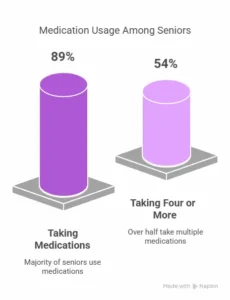Polypharmacy, the concurrent use of multiple medications, presents a significant challenge in healthcare, particularly for older adults. Managing multiple prescriptions can lead to medication errors, increased adverse drug reactions, and overall safety concerns. It is crucial for caregivers, healthcare professionals, and patients themselves to recognize the complexities associated with polypharmacy to ensure medication safety and effectiveness.
The incidence of polypharmacy is rising, with a substantial portion of the elderly population affected. According to data from The Irish Longitudinal Study on Ageing, approximately 27% of older adults are engaged in polypharmacy. The prevalence increases with age, with up to 60.8% of individuals aged 70 and older affected.
| Age Group | Percentage Experiencing Polypharmacy |
|---|---|
| Older Adults (General) | 27% |
| Adults Aged 70+ | 49% – 60.8% |
As older adults manage chronic conditions, the number of prescribed medications often increases, complicating adherence and increasing the risk of adverse drug interactions. Research highlights that nearly half of cognitively impaired adults and 43.6% of older adults in Japan are prescribed potentially inappropriate medications, increasing their risk of complications.
Polypharmacy significantly raises the likelihood of adverse drug reactions, medication mismanagement, and overall health deterioration. Studies indicate that:
Certain medications can induce drowsiness or confusion, increasing the likelihood of falls and accidents, particularly among frail adults over 60. These risks emphasize the necessity of stringent medication management, regular reviews, and open communication between patients and healthcare providers to mitigate the dangers of polypharmacy.
Proper medication adherence plays a vital role in maintaining the health and well-being of older adults. Failure to take medications as prescribed can result in severe health consequences, including complications related to chronic conditions such as cardiovascular diseases and kidney dysfunction.
Studies reveal that:
| Age Group | Percentage Taking Medications |
|---|---|
| 65 and older | 89% |
| Taking four or more medications | 54% |

Maintaining adherence reduces hospitalizations and enhances overall health outcomes, making it essential to implement strategies that support consistent medication use.
Several factors influence medication adherence among older adults:
By addressing these barriers, healthcare professionals can develop effective strategies to enhance medication compliance, ultimately improving health outcomes for older adults.
Ensuring medication safety among older adults requires a proactive approach, including preventing drug interactions and establishing effective monitoring systems.
Polypharmacy increases the risk of drug interactions, with approximately 34% of older adults in the U.S. experiencing potential medication conflicts. In Sweden, this figure reaches 82%. To reduce the risks associated with drug interactions, older adults and caregivers should:
| Risk Factor | Consideration |
|---|---|
| Multiple Prescriptions | Increased risk of drug interactions |
| Over-the-Counter Medications | Potential for unintended conflicts with prescriptions |
| Dietary Supplements | Possible interactions with prescribed medications |
Effective monitoring of medication use ensures that medications remain necessary, effective, and safe. Key strategies include:
| Monitoring Strategy | Benefit |
|---|---|
| Annual Medication Reviews | Identifies unnecessary or harmful medications |
| Accurate Documentation | Tracks effectiveness and potential side effects |
| Telepharmacy Support | Improves accessibility to healthcare guidance |
By implementing these strategies, older adults can maintain safer medication practices, reducing the risk of adverse effects.
Ensuring that older adults have access to necessary medications is a critical component of healthcare. Medicare Part D provides prescription drug coverage, but understanding plan options and costs is essential for seniors and caregivers.
Medicare Part D helps older adults afford their medications by offering a variety of plans tailored to different needs.
| Feature | Description |
|---|---|
| Eligibility | Available for individuals enrolled in Medicare |
| Coverage | Includes a broad range of prescription drugs |
| Costs | Involves premiums, deductibles, and copayments |
| Enrollment Periods | Open annually during the fall |
For details on the latest policy changes, refer to The 9 Biggest Changes Under the New Prescription Drug Law.
Financial barriers often prevent seniors from accessing essential medications. Research indicates:
| Barrier | Percentage of Affected Seniors |
|---|---|
| High Medication Costs | 23% |
| Insufficient Insurance Coverage | 15% |
| Transportation Difficulties | 12% |
| Confusion Regarding Coverage | 10% |
Addressing these challenges through financial assistance programs, caregiver support, and better insurance education can improve medication access for older adults.
Healthcare professionals are instrumental in ensuring medication safety for older adults through patient education and ongoing support.
Providing clear, comprehensive information about medications helps older adults understand their prescriptions and their impact on health. Studies indicate that poor medication adherence increases risks of complications such as kidney disease and cardiovascular issues. Healthcare providers should utilize trusted resources like AARP to guide seniors in making informed medication decisions.
Healthcare providers should implement strategies to simplify medication regimens and enhance adherence:
| Strategy | Description |
|---|---|
| Medication Reviews | Assess the necessity and effectiveness of prescriptions |
| Reminder Systems | Use tools and reminders for timely medication intake |
| Simplified Regimens | Reduce the frequency of dosages for better adherence |
| Patient Engagement | Encourage open discussions about medication concerns |
By integrating these strategies, healthcare providers can help older adults manage their medications safely, reducing the risk of adverse effects and improving their overall quality of life.
Send Us An Email